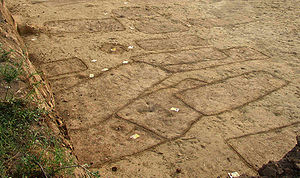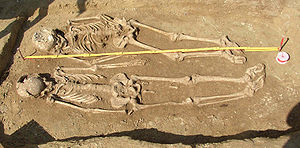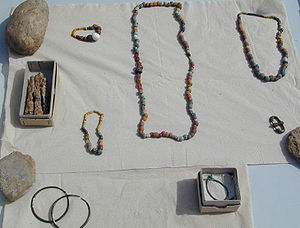
Grave field
Encyclopedia

Cemetery
A cemetery is a place in which dead bodies and cremated remains are buried. The term "cemetery" implies that the land is specifically designated as a burying ground. Cemeteries in the Western world are where the final ceremonies of death are observed...
, typically of Bronze Age
Bronze Age Europe
The European Bronze Age is characterized by bronze artifacts and the use of bronze implements. The regional Bronze Age succeeds the Neolithic, it starts with the Aegean Bronze Age 3200 BC...
and Iron Age Europe.
Grave fields are distinguished from necropoleis
Necropolis
A necropolis is a large cemetery or burial ground, usually including structural tombs. The word comes from the Greek νεκρόπολις - nekropolis, literally meaning "city of the dead"...
by the former's lack of above-ground structures, buildings, or grave markers.
Types
Grave fields can be classified by type of burial custom:- tumulusTumulusA tumulus is a mound of earth and stones raised over a grave or graves. Tumuli are also known as barrows, burial mounds, Hügelgrab or kurgans, and can be found throughout much of the world. A tumulus composed largely or entirely of stones is usually referred to as a cairn...
(kurganKurganKurgan is the Turkic term for a tumulus; mound of earth and stones raised over a grave or graves, originating with its use in Soviet archaeology, now widely used for tumuli in the context of Eastern European and Central Asian archaeology....
) fields - row graves: grave fields arranged in rows
- ossuariesOssuaryAn ossuary is a chest, building, well, or site made to serve as the final resting place of human skeletal remains. They are frequently used where burial space is scarce. A body is first buried in a temporary grave, then after some years the skeletal remains are removed and placed in an ossuary...
- shaft tombShaft tombA shaft tomb or shaft grave is a type of burial structure formed from a deep and narrow shaft sunk into natural rock. Burials were then placed at the bottom...
s - urnfields
Celtic grave fields
Hallstatt cultureHallstatt culture
The Hallstatt culture was the predominant Central European culture from the 8th to 6th centuries BC , developing out of the Urnfield culture of the 12th century BC and followed in much of Central Europe by the La Tène culture.By the 6th century BC, the Hallstatt culture extended for some...
- Kinding-Ilbling, Eichstätt districtEichstätt (district)Eichstätt is a district in Bavaria, Germany. It is bounded by the districts of Neuburg-Schrobenhausen, Donau-Ries, Weißenburg-Gunzenhausen, Roth, Neumarkt, Kelheim and Pfaffenhofen, and by the city of Ingolstadt.-History:...
, Germany
La Tène culture
La Tène culture
The La Tène culture was a European Iron Age culture named after the archaeological site of La Tène on the north side of Lake Neuchâtel in Switzerland, where a rich cache of artifacts was discovered by Hansli Kopp in 1857....
- Münsingen-Rain, BerneBerneThe city of Bern or Berne is the Bundesstadt of Switzerland, and, with a population of , the fourth most populous city in Switzerland. The Bern agglomeration, which includes 43 municipalities, has a population of 349,000. The metropolitan area had a population of 660,000 in 2000...
, Germany
Scandinavia
Nordic Bronze AgeNordic Bronze Age
The Nordic Bronze Age is the name given by Oscar Montelius to a period and a Bronze Age culture in Scandinavian pre-history, c. 1700-500 BC, with sites that reached as far east as Estonia. Succeeding the Late Neolithic culture, its ethnic and linguistic affinities are unknown in the absence of...
- SammallahdenmäkiSammallahdenmäkiSammallahdenmäki is a Bronze age burial site in Finland in Lappi municipality. It was designated by UNESCO as a World Heritage Site in 1999, and includes 36 granite burial cairns dating back more than 3,000 years, to 1,500 to 500 BC. It is located on a hill in a remote area off the road between...
, Finland - Ekornavallen, Falköping MunicipalityFalköping MunicipalityFalköping Municipality is a municipality in Västra Götaland County in western Sweden. Its seat is located in the city of Falköping....
, Sweden - Gettlinge, ÖlandÖland' is the second largest Swedish island and the smallest of the traditional provinces of Sweden. Öland has an area of 1,342 km² and is located in the Baltic Sea just off the coast of Småland. The island has 25,000 inhabitants, but during Swedish Midsummer it is visited by up to 500,000 people...
, Sweden - ItzehoeItzehoeItzehoe is a town in the German state of Schleswig-Holstein.As the capital of the district Steinburg, Itzehoe is located on the Stör, a navigable tributary of the Elbe, 51 km northwest of Hamburg and 24 km north of Glückstadt...
tumulus, Germany
Vendel period
- GrebyGrebyThe Greby grave field is an Iron Age grave field in western Sweden. It is located north of Grebbestad, Tanum Municipality in Västra Götaland County. With its over 180 graves, it is the largest site of this kind in Bohuslän....
, BohuslänBohuslän' is a Swedish traditional province, or landskap, situated in Götaland on the northernmost part of the country's west coast. It is bordered by Dalsland to the northeast, Västergötland to the southeast, the Skagerrak arm of the North Sea to the west, and the county of Østfold in Norway to the north...
, Sweden - Smålandsstenar, Gislaved MunicipalityGislaved MunicipalityGislaved Municipality is a municipality in Jönköping County in southern Sweden, with its seat located in the town Gislaved.The present municipality was formed in 1974, whenformer municipalities were amalgamated...
, Sweden - Trullhalsar, GotlandGotlandGotland is a county, province, municipality and diocese of Sweden; it is Sweden's largest island and the largest island in the Baltic Sea. At 3,140 square kilometers in area, the region makes up less than one percent of Sweden's total land area...
, Sweden - Blomsholm, BohuslänBohuslän' is a Swedish traditional province, or landskap, situated in Götaland on the northernmost part of the country's west coast. It is bordered by Dalsland to the northeast, Västergötland to the southeast, the Skagerrak arm of the North Sea to the west, and the county of Østfold in Norway to the north...
, Sweden - Högom, MedelpadMedelpad' is a historical province or landskap in the north of Sweden. It borders to Hälsingland, Härjedalen, Jämtland, Ångermanland and the Gulf of Bothnia....
, Sweden - VätterydVätterydThe Vätteryd grave field , also known as Vätterydshed, is an Iron Age grave field in Hässleholm Municipality in the Swedish province of Scania. It is located in a heathfield between the localities of Tjörnarp and Sösdala....
, Skåne CountySkåne CountySkåne County is the southernmost administrative county or län, of Sweden, basically corresponding to the historical province Scania. It borders the counties of Halland, Kronoberg and Blekinge. The seat of residence for the Skåne Governor is the town of Malmö...
, Sweden - Hjortahammar, BlekingeBlekinge' is one of the traditional provinces of Sweden , situated in the south of the country. It borders Småland, Scania and the Baltic Sea.The name "Blekinge" comes from the adjective bleke, which corresponds to the nautical term for "dead calm"....
, Sweden - Li, HallandHalland' is one of the traditional provinces of Sweden , on the western coast of Sweden. It borders Västergötland, Småland, Scania and the sea of Kattegat.-Administration:...
, Sweden - ValsgärdeValsgärdeValsgärde or Vallsgärde is a farm on the Fyris river, about three kilometres north of Gamla Uppsala, the ancient centre of the Swedish kings and of the pagan faith in Sweden. The present farm dates from the 16th century. The farm's notability derives from the presence of a burial site from the...
, Uppsala CountyUppsala CountyUppsala County is a county or län on the eastern coast of Sweden. It borders the counties of Stockholm, Södermanland, Västmanland, Gävleborg, and the Baltic Sea.- Province :For History, Geography and Culture see: Uppland...
, Sweden
Viking Age
Viking Age
Viking Age is the term for the period in European history, especially Northern European and Scandinavian history, spanning the late 8th to 11th centuries. Scandinavian Vikings explored Europe by its oceans and rivers through trade and warfare. The Vikings also reached Iceland, Greenland,...
- Järvsta, GävleGävleGävle is a city in Sweden, the seat of Gävle Municipality and the capital of Gävleborg County. It had 71,033 inhabitants in 12/31 2010. It is the oldest city in the historical Norrland , having received its charter in 1446 from Christopher of Bavaria.-History:It is believed that the name Gävle...
, Sweden
Alemannic grave fields

Cremation
Cremation is the process of reducing bodies to basic chemical compounds such as gasses and bone fragments. This is accomplished through high-temperature burning, vaporization and oxidation....
. In the mid- to late fifth century, burial customs appear to change, with the introduction of larger row-grave fields.
Grave fields are often arranged on elevated ground outside settlements. The arrangement of graves is often east to west — the head of the body placed on the western end, looking east.
Until the beginning of the sixth century, these row graves are accompanied by more prestigious single graves including precious grave goods. Quast (1997) assumes that the fifth-century change in burial practice was due to a renewed influx of Elbe Germanic settlers (Danube Swabians
Danube Swabians
The Danube Swabians is a collective term for the German-speaking population who lived in the former Kingdom of Hungary, especially alongside the Danube River valley. Because of different developments within the territory settled, the Danube Swabians cannot be seen as a unified people...
displaced by Gothic
Goths
The Goths were an East Germanic tribe of Scandinavian origin whose two branches, the Visigoths and the Ostrogoths, played an important role in the fall of the Roman Empire and the emergence of Medieval Europe....
migration).
Male graves often include weapons — in the mid-fifth century typically a Francisca
Francisca
The francisca is a throwing axe used as a weapon during the Early Middle Ages by the Franks, among whom it was a characteristic national weapon at the time of the Merovingians from about 500 to 750 AD and is known to have been used during the reign of Charlemagne .Although generally associated...
axe, besides spathas
Migration Period sword
Swords of the Migration Period show a transition from the Roman era Spatha to the "Viking sword" types of the Early Middle Ages....
and seax
Seax
Seax in Old English means knife or cutting tool. The name of the roofer's tool, the zax, is a development from this word...
es. Female graves often include jewellery, such as bracelets, ear-rings and Fibula (brooch).

Lauchheim
Lauchheim is a town in the Ostalbkreis district, in Baden-Württemberg, Germany. It is situated on the river Jagst, 12 km northeast of Aalen....
, Gammertingen
Gammertingen
Gammertingen is a town in the district of Sigmaringen, in Baden-Württemberg, Germany. It is situated 18 km north of Sigmaringen....
, Weingarten
Weingarten (Württemberg)
Weingarten is a town with a population of 24,000 in Württemberg, in the District of Ravensburg, in the valley of the Schussen River. Together with the southern neighbour cities of Ravensburg and Friedrichshafen on Lake Constance , it forms one of 14 medium-sized infrastructural centres in...
, Ravensburg
Ravensburg
Ravensburg is a town in Upper Swabia in Southern Germany, capital of the district of Ravensburg, Baden-Württemberg.Ravensburg was first mentioned in 1088. In the Middle Ages, it was an Imperial Free City and an important trading centre...
, all in Swabia
Swabia
Swabia is a cultural, historic and linguistic region in southwestern Germany.-Geography:Like many cultural regions of Europe, Swabia's borders are not clearly defined...
, the one in Ravensburg including over 1,000 graves dating to between AD 450 and 710. The field in Sasbach
Sasbach
Sasbach may refer to two towns in Baden-Württemberg, Germany:*Sasbach , in the Ortenau district*Sasbach am Kaiserstuhl, in the district of Emmendingen...
includes over 2,000 graves. Mengen
Mengen, Germany
Mengen is a town in the district of Sigmaringen, in Baden-Württemberg, Germany. It is situated 9 km southeast of Sigmaringen....
has over 1,000 graves.
Alemannic graves appear south of the Rhine, in the Swiss Plateau
Swiss plateau
The Swiss Plateau or Central Plateau constitutes one of the three major landscapes in Switzerland alongside the Jura mountains and the Swiss Alps. It covers about 30% of the Swiss surface...
, from the 500s. Alemannic colonization of the Swiss plateau apparently took place from the Basel
Basel
Basel or Basle In the national languages of Switzerland the city is also known as Bâle , Basilea and Basilea is Switzerland's third most populous city with about 166,000 inhabitants. Located where the Swiss, French and German borders meet, Basel also has suburbs in France and Germany...
area, since the number of graves there declines simultaneously. Significant influx of Alemannic settlers to the Swiss plateau begins only in the 7th century. Grave fields from this period include one at Elgg
Elgg
Elgg is a municipality in the district of Winterthur in the canton of Zürich in Switzerland.-History:Elgg is first mentioned between 760 and 763 as Ailaghoga...
-Ettenbühl near Winterthur
Winterthur
Winterthur is a city in the canton of Zurich in northern Switzerland. It has the country's sixth largest population with an estimate of more than 100,000 people. In the local dialect and by its inhabitants, it is usually abbreviated to Winti...
; with 340 graves it is the largest field south of the High Rhine
High Rhine
The High Rhine is the name used in Germany for the part of the Rhine River that flows westbound from Lake Constance to Basel.The High Rhine begins at the outflow of the Rhine from the Untersee in Stein am Rhein and turns into the Upper Rhine in Basel...
.
Christianization
Germanic Christianity
The Germanic people underwent gradual Christianization in the course of Late Antiquity and the Early Middle Ages. By the 8th century, England and the Frankish Empire were Christian, and by AD 1100 Germanic paganism had also ceased to have political influence in Scandinavia.-History:In the 4th...
of the Alemanni during the 7th century brings about the end of the grave field traditions. The dead from this period were buried in graveyard
Graveyard
A graveyard is any place set aside for long-term burial of the dead, with or without monuments such as headstones...
s near churches. Prestigious graves of local nobility appears to have resisted the Christianization of burial customs into the eighth century, possibly until the 786 decree of Charlemagne
Charlemagne
Charlemagne was King of the Franks from 768 and Emperor of the Romans from 800 to his death in 814. He expanded the Frankish kingdom into an empire that incorporated much of Western and Central Europe. During his reign, he conquered Italy and was crowned by Pope Leo III on 25 December 800...
outlawing pagan burial.
See also
- Burial mound
- Megalithic tomb
- Viking funeralViking funeralBurial customs of Viking Age Norsemen are known both from archaeology and from historical accounts such as the Icelandic sagas, Old Norse poetry, and notably from the account of Ahmad ibn Fadlan....
- Ship burialShip burialA ship burial or boat grave is a burial in which a ship or boat is used either as a container for the dead and the grave goods, or as a part of the grave goods itself. If the ship is very small, it is called a boat grave...
- Chariot burialChariot burialChariot burials are tombs in which the deceased was buried together with his chariot, usually including his horses and other possessions....

